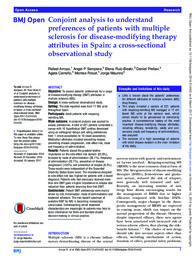Por favor, use este identificador para citar o enlazar este ítem:
https://hdl.handle.net/11000/30938Registro completo de metadatos
| Campo DC | Valor | Lengua/Idioma |
|---|---|---|
| dc.contributor.author | Arroyo, Rafael | - |
| dc.contributor.author | Perez-Sempere, Angel | - |
| dc.contributor.author | Ruiz-Beato, Elena | - |
| dc.contributor.author | Prefasi, Daniel | - |
| dc.contributor.author | Carreño, Agata | - |
| dc.contributor.author | Roset, Montse | - |
| dc.contributor.author | Maurino, Jorge | - |
| dc.contributor.other | Departamentos de la UMH::Medicina Clínica | es_ES |
| dc.date.accessioned | 2024-02-01T13:07:24Z | - |
| dc.date.available | 2024-02-01T13:07:24Z | - |
| dc.date.created | 2017-03 | - |
| dc.identifier.citation | BMJ Open . 2017 Mar 8;7(3):e014433 | es_ES |
| dc.identifier.issn | 2044-6055 | - |
| dc.identifier.uri | https://hdl.handle.net/11000/30938 | - |
| dc.description.abstract | Objective: To assess patients' preferences for a range of disease-modifying therapy (DMT) attributes in multiple sclerosis (MS). Design: A cross-sectional observational study. Setting: The data reported were from 17 MS units throughout Spain. Participants: Adult patients with relapsing-remitting MS. Main outcome: A conjoint analysis was applied to assess preferences. A total of 221 patients completed a survey with 10 hypothetical DMT profiles developed using an orthogonal design and rating preferences from 1 (most acceptable) to 10 (least acceptable). Medication attributes included preventing relapse, preventing disease progression, side effect risk, route and frequency of administration. Results: Patients placed the greatest relative importance on the side effect risk domain (32.9%), followed by route of administration (26.1%), frequency of administration (22.7%), prevention of disease progression (10.0%) and prevention of relapse (8.3%). These results were independent of the Expanded Disability Status Scale score. The importance assigned to side effect risk was highest for patients with a recent diagnosis. Patients who had previously received more than one DMT gave a higher importance to relapse rate reduction than patients receiving their first DMT. Conclusions: Patient DMT preferences were mainly driven by risk minimisation, route of administration and treatment schedule. The risk-benefit spectrum of available DMT for MS is becoming increasingly complicated. Understanding which treatment characteristics are meaningful to patients may help to tailor information for them and facilitate shared decision-making in clinical practice. | es_ES |
| dc.format | application/pdf | es_ES |
| dc.format.extent | 8 | es_ES |
| dc.language.iso | eng | es_ES |
| dc.publisher | BMJ | es_ES |
| dc.rights | info:eu-repo/semantics/openAccess | es_ES |
| dc.rights | Attribution-NonCommercial-NoDerivatives 4.0 Internacional | * |
| dc.rights.uri | http://creativecommons.org/licenses/by-nc-nd/4.0/ | * |
| dc.subject | conjoint analysis | es_ES |
| dc.subject | disease-modifying therapies | es_ES |
| dc.subject | patient preferences | es_ES |
| dc.subject | rating-based experiment | es_ES |
| dc.title | Conjoint analysis to understand preferences of patients with multiple sclerosis for disease-modifying therapy attributes in Spain: a cross-sectional observational study | es_ES |
| dc.type | info:eu-repo/semantics/article | es_ES |
| dc.relation.publisherversion | https://doi.org/10.1136/bmjopen-2016-014433 | es_ES |

Ver/Abrir:
Conjoint analysis to understand.pdf
1,1 MB
Adobe PDF
Compartir:
 La licencia se describe como: Atribución-NonComercial-NoDerivada 4.0 Internacional.
La licencia se describe como: Atribución-NonComercial-NoDerivada 4.0 Internacional.
.png)